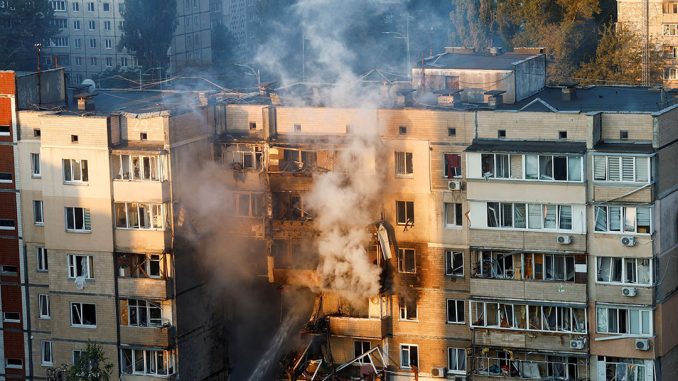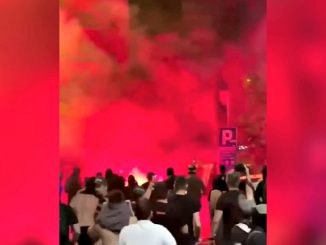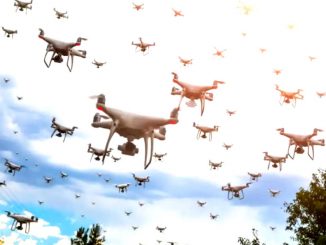
Published October 5, 2025
In the early hours of Sunday, October 5, 2025, Russia launched a significant missile and drone attack on Ukraine, marking one of the most extensive aerial assaults since the onset of the war. Ukrainian President Volodymyr Zelenskyy reported that over 50 missiles and approximately 500 drones were deployed across the country, resulting in at least five civilian deaths and numerous injuries.
Widespread Damage Across Multiple Regions
The strikes targeted several regions, including Lviv, Ivano-Frankivsk, Zaporizhzhia, Chernihiv, Sumy, Kharkiv, Kherson, Odesa, and Kirovohrad. In Lviv, near the Polish border, at least four people were killed, and four others were injured when an industrial park and residential buildings were hit. The city experienced power outages and significant damage to infrastructure .
In Zaporizhzhia, a southern frontline region, one person was killed, and ten others were injured. The attack caused damage to gas pipelines and left over 73,000 residents without power .
Poland Responds to Border Threats
The proximity of the attacks to NATO member Poland prompted immediate action. Poland scrambled aircraft to secure its airspace and placed air defense systems on high alert. Additionally, Lithuania closed Vilnius Airport temporarily due to potential aerial threat.
International Reactions and Calls for Action
Ukrainian officials condemned the attacks as deliberate targeting of civilians and critical infrastructure. President Zelenskyy emphasized the need for enhanced air defense and called on international allies to expedite support to counter the aerial threats .
The scale and coordination of this assault underscore the ongoing volatility in the region and the heightened risks to both Ukrainian civilians and neighboring NATO countries. The international community continues to monitor the situation closely, with discussions on increasing defensive measures and diplomatic efforts to de-escalate tensions.
 Public / Political Reactions to Russia’s October 5, 2025, Drone and Missile Attack on Ukraine
Public / Political Reactions to Russia’s October 5, 2025, Drone and Missile Attack on Ukraine
The massive overnight assault by Russia on Ukraine on October 5, 2025, has elicited strong reactions from both Ukrainian citizens and the international community.
🇺🇦 Ukrainian Public Sentiment
In Ukraine, the public response has been one of shock and defiance. The attack, which resulted in at least five civilian deaths and significant infrastructure damage, has intensified feelings of vulnerability and anger among the populace. Many Ukrainians are expressing frustration over the ongoing conflict and the toll it continues to take on civilian life.
Ukrainian President Volodymyr Zelenskyy has condemned the strikes as acts of terrorism and called for increased international support to bolster Ukraine’s defense capabilities. He emphasized the need for enhanced air defense systems and greater military aid to protect civilians and critical infrastructure.
🌍 International Reactions
Poland and NATO’s Response
Poland, sharing a border with Ukraine, responded swiftly to the threat. The Polish military scrambled fighter jets to secure its airspace and deployed air defense systems to protect against potential incursions. This move underscores the heightened security concerns among NATO member states in the region.
European Union and United States
The European Union and the United States have condemned the attacks, labeling them as violations of international law and calls for an immediate cessation of hostilities. Leaders from both blocs have reiterated their commitment to supporting Ukraine through sanctions against Russia and increased military aid.
United Nations
The United Nations has expressed grave concern over the escalation of violence and its impact on civilians. The UN has called for an independent investigation into the attacks and urged all parties to adhere to international humanitarian law.
🧭 Broader Implications
This latest assault marks a significant escalation in the conflict, with the use of over 500 drones and 50 missiles targeting multiple regions across Ukraine. The proximity of the attacks to NATO member states has raised alarms about the potential for broader regional instability.
The international community is closely monitoring the situation, with discussions underway about further sanctions on Russia and additional support for Ukraine. The events of October 5 serve as a stark reminder of the ongoing volatility in the region and the urgent need for diplomatic efforts to de-escalate tensions.
 Resulting Effects of Russia’s October 5, 2025, Drone and Missile Attack on Ukraine
Resulting Effects of Russia’s October 5, 2025, Drone and Missile Attack on Ukraine
⚡ Humanitarian Impact
-
The overnight assault caused at least five civilian deaths and dozens of injuries across multiple Ukrainian regions.
-
Thousands of residents experienced power outages, disrupted gas supplies, and damage to homes and industrial facilities, particularly in Lviv and Zaporizhzhia.
-
Hospitals and emergency services were overwhelmed, highlighting vulnerabilities in civilian protection and disaster response.
🏗️ Infrastructure and Energy
-
Critical infrastructure, including energy grids, gas pipelines, and industrial sites, suffered significant damage.
-
Power outages affected over 73,000 residents, disrupting daily life and local economies.
-
Repairs are expected to take weeks, straining Ukraine’s already fragile infrastructure and creating a potential long-term economic burden.
🛡️ Military and Defense Implications
-
The use of over 500 drones and 50 missiles demonstrates Russia’s growing reliance on unmanned aerial systems for large-scale attacks.
-
Ukraine’s air defense capabilities are being tested; officials called for increased international military aid and enhanced air defense systems.
-
NATO members, especially Poland and Lithuania, are placing air defense units on high alert, indicating a risk of escalation near NATO borders.
🌐 Regional and Global Effects
-
The attack heightened tensions along Ukraine’s western borders, prompting NATO nations to scramble aircraft and bolster defense readiness.
-
Increased civilian casualties and infrastructure damage may influence future diplomatic negotiations, sanctions, and global support for Ukraine.
-
The scale of the assault underscores the risk of broader regional instability, drawing international attention to potential escalation.
 Future Outlook
Future Outlook
🔮 Short-Term Outlook
-
Ukraine is expected to fortify its air defenses, particularly in regions near NATO borders, to counter further drone and missile attacks.
-
Civilian infrastructure may continue to be vulnerable, with repair and recovery efforts likely taking weeks or months.
-
The immediate aftermath may see heightened alert levels in neighboring NATO countries, including Poland and Lithuania, to prevent cross-border incidents.
⚔️ Military Developments
-
Russia’s reliance on drone swarms and missile strikes suggests continued strategic focus on aerial attacks to disrupt Ukraine’s infrastructure and morale.
-
Ukraine may accelerate procurement and deployment of advanced air defense systems from allies, potentially shifting the balance in key regions.
-
Escalation in drone warfare tactics could influence future combat strategies for both sides and may spur increased investment in counter-drone technologies globally.
🌐 Regional and International Implications
-
NATO countries are likely to increase military readiness and conduct joint exercises near Eastern Europe to signal deterrence.
-
Diplomatic pressure on Russia could intensify, with potential new sanctions targeting defense, energy, and technology sectors.
-
International humanitarian organizations may expand aid operations in Ukraine to address growing civilian needs caused by repeated attacks.
📈 Long-Term Strategic Considerations
-
Continued attacks may weaken Ukraine’s energy and industrial infrastructure, affecting long-term economic recovery and stability.
-
Prolonged conflict increases the risk of regional spillover, particularly near NATO borders, potentially prompting further international involvement.
-
The situation underscores the importance of diplomatic channels and multilateral support to prevent escalation into a broader European or global confrontation.
🧭 Strategic Outlook
-
Repeated large-scale drone and missile attacks may force Ukraine to adapt defensive strategies, including relocation of critical infrastructure.
-
Russia’s continued escalation signals a prolonged conflict, likely extending the humanitarian and economic strain on Ukraine.
-
The international community’s response, including military aid and sanctions, will be critical in deterring further aggressive actions.
 Bottom Line:
Bottom Line:
The October 5, 2025, Russian drone and missile assault on Ukraine represents one of the most extensive attacks in the ongoing conflict, highlighting the devastating human, infrastructural, and geopolitical consequences of modern warfare. Civilians bore the immediate brunt, with lives lost, injuries sustained, and essential services disrupted. Ukraine’s air defenses and emergency systems are under unprecedented pressure, while neighboring NATO countries remain on high alert, reflecting the broader regional risk.
This escalation underscores the urgent need for sustained international support, including military aid, humanitarian assistance, and diplomatic engagement, to protect Ukraine’s sovereignty and prevent further destabilization. As Russia continues to rely on drone swarms and missile strikes, the conflict shows no signs of abating, emphasizing that both defensive measures and global diplomatic efforts will be critical in shaping the region’s security and the future of European stability.
SOURCES: THE BUSINESS WORD – Russia rains drones and missiles on Ukraine; Poland scrambles aircraft
GRANTS PASS TRIBUNE – Russia Launches Major Overnight Assault on Ukraine, Civilian Deaths Reported
ABC NEWS – Russia fires 500 drones at Ukraine in deadly overnight attack, Zelenskyy says





Be the first to comment